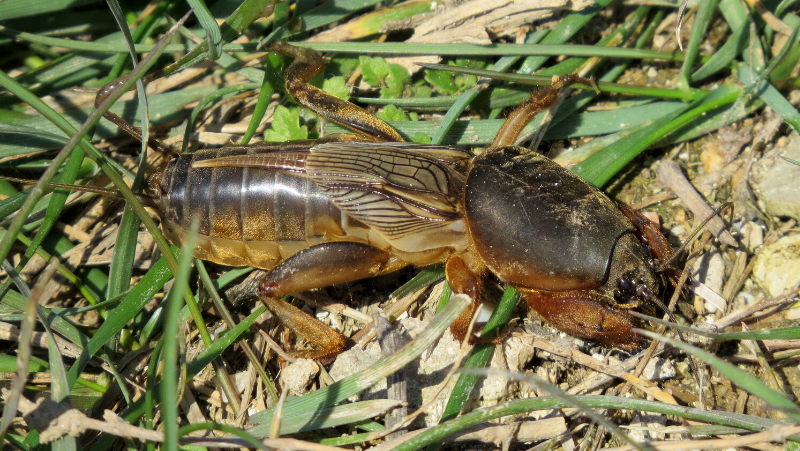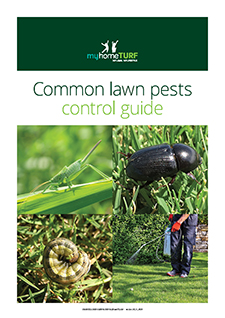7 Common Weeds in Buffalo Grass
Weeds in Buffalo lawns can quickly turn your dream lawn into a nightmare. For Australian homeowners, tackling these invasive plants is essential for preserving the beauty and ...

 Mole Crickets are a burrowing insect that is found across most of Australia but is especially common in Greater Sydney and the Central Coast of New South Wales.
Mole Crickets are a burrowing insect that is found across most of Australia but is especially common in Greater Sydney and the Central Coast of New South Wales.
Mole Crickets live in a deep, vertical burrow and can bunker down in it during winter.
Once winter temperatures begin to rise, Mole Crickets will work their way back up to the surface to feed on grass and roots.
Mole Crickets are almost never seen in the daytime, preferring to feed underground or at night, but can be attracted to artificial light at night.
Mole Crickets are easily distinguished from Black Field Crickets by the shape of their head and the powerful front legs with spade-like feet for digging. They are usually brown, 40mm to 50mm long, and adult Mole Crickets usually have stubby wings which they use during mating.
The male Mole Cricket sits at the entrance of their burrow to call for a mate, especially after watering or rain.
Once a year, in spring or summer, female Mole Crickets lay eggs in their burrow and guard them until they hatch into wingless nymphs.
Mole Crickets can damage your lawn by chewing on the roots and creating networks of tunnels underground.
By the time damage is obvious, it is usually more difficult to control Mole Crickets.
The best way to confirm the presence of Mole Crickets in your lawn is by pouring a bucket of soapy water – containing 40ml of dishwashing detergent to 3.8L of water – over an area of 30 to 60 square centimetres, late at night or early in the morning.
This will quickly flush out any nymphs or adult Mole Crickets, allowing you to decide how big the problem is and how best to tackle it.
One of the best methods of controlling Mole Crickets is to poke around your lawn at night when they’re active.
With the aid of a head torch, available from most camping or hardware stores, you can pounce on these pests and crush them or drown them with a bucket of soapy water.
Take care when handling Mole Crickets – they can pinch or bite and will often release a foul-smelling liquid from their anal glands when caught.
If they’re shy, try setting a honey or beer trap: set a smooth-walled glass or plastic container into the ground, fill to a quarter of its depth with honey or beer and cover the top with a sheet of iron and some straw. Check each morning.
 Mole Crickets are most susceptible to pesticides when they’re at the nymph stage before they’ve had a chance to develop a thicker exoskeleton and burrow deeper into the soil.
Mole Crickets are most susceptible to pesticides when they’re at the nymph stage before they’ve had a chance to develop a thicker exoskeleton and burrow deeper into the soil.
Apply spray, granules, or baits when overnight temperatures are above 16 degrees Celsius and irrigate the soil as this helps the pesticide penetrate into the soil and encourages the crickets to move up towards the surface.
Repeat treatments may be necessary.
Look for products containing the active ingredients abamectin, beta-cyfluthrin, bifenthrin, imidacloprid, esfenvelerate or chlorantraniliprole.
Always read the safety directions and instructions on the product label before use.
If you prefer more natural methods, there’s a non-toxic foliar spray or soil drench made from Neem oil extract which kills and repels Mole Crickets.
Used properly it is safe for humans and does not target beneficial insects such as Bees, Butterflies and Ladybugs.
Please check with your local nursery or garden centre for recommendations
Keep your lawn as healthy and vigorous as possible with regular application of fertiliser, deep watering and mowing at the optimum height for your lawn variety.
Where cracks appear in the ground, fill them in, and take steps to reduce thick layers of thatch which can attract Mole Crickets.
Beneficial insects, such as Parasitic Wasps and Flies, can help keep Mole Crickets under control.
There are also products containing Predatory Nematodes which can be applied with a watering can, pump sprayer or knapsack that are available commercially.
Predatory Nematodes are safe to use around humans and pets and won’t harm Bees or contaminate groundwater.
Sign up for our Newsletter to receive your free guide.
